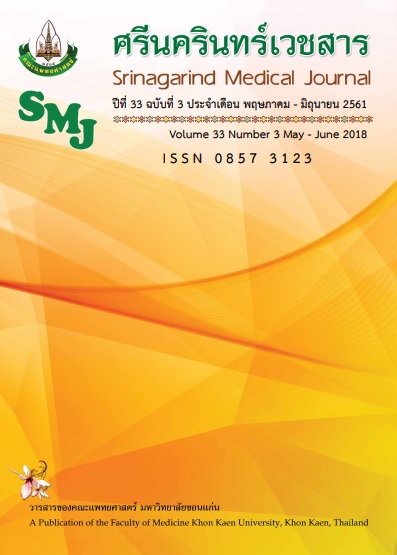Construction of Genomic DNA Library of Bacillus amyloliquefaciens KKU14 Harboring Antimicrobial Activities Against Burkholderia pseudomallei
Abstract
Background and Objective: Melioidosis is a serious community-acquired infectious disease caused by a Gram-negative bacterium Burkholderia pseudomallei. Several strains are highly resistant to almost all available antibiotic drugs, so the discovery of novel potential drugs becomes strictly necessary. Previous study indicated that antimicrobial peptides (AMPs) produced by Bacillus amyloliquefaciens KKU14 showed a broad spectrum of activity to strongly inhibit B. pseudomallei. In this study, genes encoding AMP against B. pseudomallei from the genome of B. amyloliquefaciens KKU14 were investigated through genomic DNA library. The identified AMP genes can be further characterized.
Materials and Methods: The genomic DNA library of B. amyloliquefaciens KKU14 was constructed by using pCC2FOS vector. The library clones were overlaid by soft agar containing B. pseudomallei strain P37. The clones with clear zones were confirmed by agar well diffusion method.
Results: Genomic libraries of B. amyloliquefaciens KKU14 were successfully constructed. Five recombinant clones with approximately 30-40 kb genome fragments exhibited antimicrobial activities against B. pseudomallei strain P37 as observed by soft agar overlay assay. In agar well diffusion test, culture supernatant from one clone showed antimicrobial activities against B. pseudomallei strain P37.
Conclusion: A recombinant clone from B. amyloliquefaciens KKU14 genome showed antimicrobial activities inhibiting B.pseudomallei strain P37. DNA sequencing and data analysis will be proceeded to identify the involving genes.
การสร้างฐานข้อมูลพันธุกรรมของ Bacillus amyloliquefaciens KKU14 ที่สร้างสารต้าน Burkholderia pseudomallei
วจีอร อ้วนชารี1, 3, โชติมา โพธิทรัพย์ 1, 3, รศนา เสริมสวรรค์1, 3, อัชฌา บุญมี2, 3
1ภาควิชาชีวเคมี คณะแพทยศาสตร์ มหาวิทยาลัยขอนแก่น
2ภาควิชาจุลชีววิทยา คณะวิทยาศาสตร์ มหาวิทยาลัยขอนแก่น
3ศูนย์วิจัยโรคเมลิออยโดสิส มหาวิทยาลัยขอนแก่น
หลักการและวัตถุประสงค์: โรคเมลิออยด์เป็นโรคติดเชื้อ เกิดจากแบคทีเรีย Burkholderia pseudomallei ซึ่งเป็นเชื้อที่มีอัตราการดื้อยาปฏิชีวนะหลักสูงมาก จึงจำเป็นต้องค้นหายาชนิดใหม่ที่มีประสิทธิภาพสูงขึ้น การศึกษาก่อนหน้านี้พบว่าแบคทีเรีย B. amyloliquefaciens KKU14 สามารถสร้างสารเปปไทด์ต้านจุลชีพซึ่งยับยั้งเชื้อ B. pseudomallei ได้หลายสายพันธุ์ การศึกษานี้มีวัตถุประสงค์เพื่อหายีนที่สร้างสารเปปไทด์ต้านจุลชีพยับยั้งเชื้อ B. pseudomallei โดยการสร้างฐานข้อมูลพันธุกรรมของ B. amyloliquefaciens KKU14 ซึ่งจะเป็นประโยชน์ในการศึกษาคุณสมบัติของสารในการยับยั้งเชื้อต่อไป
วิธีการศึกษา: สร้างฐานข้อมูลพันธุกรรมของ B. amyloliquefaciens KKU14 โดยใช้เวกเตอร์ pCC2FOS ทำการคัดเลือกหาโคลนที่มีฤทธิ์ต้าน B. pseudomallei ด้วยวีธี solf agar overlay และ agar well diffusion
ผลการศึกษา: ได้สร้างฐานข้อมูลพันธุกรรมของ B. amyloliquefaciens KKU14 สำเร็จ โดยชิ้นแทรกดีเอ็นเอมีขนาดประมาณ 30-40 กิโลเบส จากการคัดเลือกเบื้องต้นด้วยวิธี solf agar overlay พบว่ามีโคลนที่สามารถยับยั้ง B. pseudomallei สายพันธุ์ P37 ได้ 5 โคลน แต่เมื่อทดสอบด้วย agar well diffusion พบว่ามี 1 โคลนที่สามารถยับยั้ง B. pseudomallei ได้
สรุป: การสร้างฐานข้อมูลพันธุกรรมของ B. amyloliquefaciens KKU14 และแสดงออกใน E. coli พบโคลนที่ออกฤทธิ์ต้าน B. pseudomallei สายพันธุ์ P37 ซึ่งจะมีการวิเคราะห์หาลำดับเบสของดีเอ็นเอเพื่อบ่งชี้ยีนที่เกี่ยวข้องต่อไป




